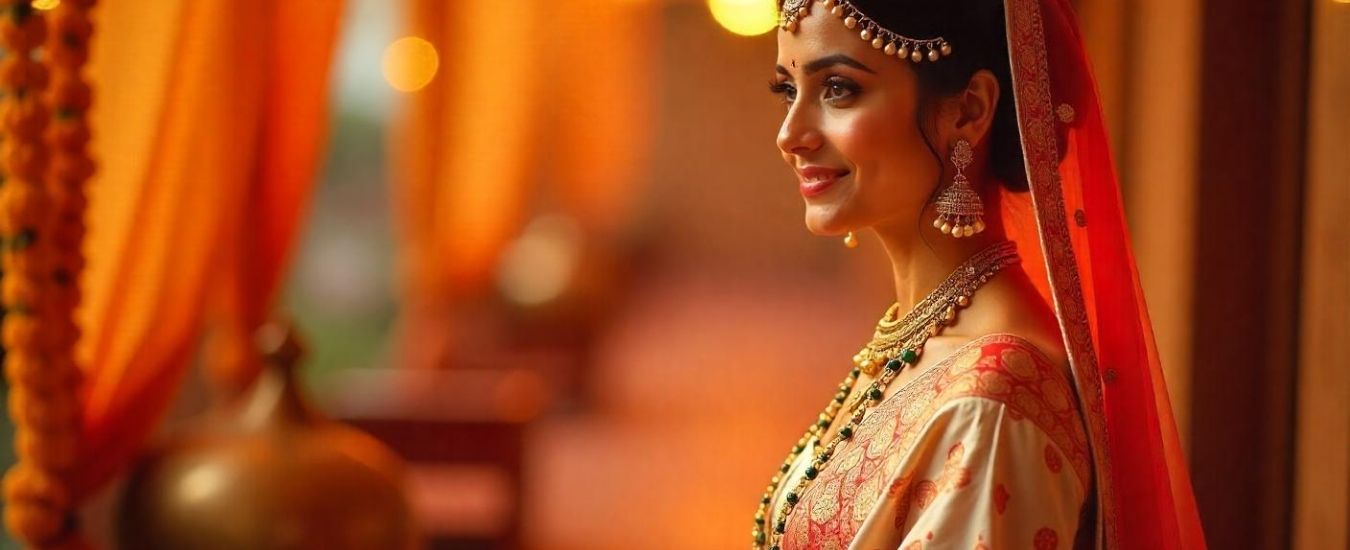The Panetar saree is more than just bridal attire—it’s a canvas of culture, a reflection of handcrafted heritage, and a beacon of Gujarati pride. Whether you’re a bride-to-be or a culture enthusiast, wearing a Panetar is like wrapping yourself in ancestral memories, sacred tradition, and artisanal excellence.
What is a Panetar Saree?
Let’s start with the basics: a Panetar saree is a stunning piece of handcrafted Indian ethnic wear traditionally worn by Gujarati brides on their wedding day. It’s not just a garment—it’s a textile tradition soaked in heritage, emotions, and family blessings.
The Symbolism Behind the Colors – Red and White
The white silk base of the Panetar signifies purity and innocence, while the red border symbolizes marital bliss, fertility, and spiritual transformation. Together, these colours narrate a silent story—of new beginnings, cultural pride, and sacred rituals.
Why It’s More Than Just Bridal Attire?
While the Panetar is central to weddings, it’s also a wearable heirloom, a gift of unconditional love from the bride’s maternal side—usually her mama (uncle). It’s not just bridal couture; it’s generational storytelling woven into silk and zari.
Historical Origins of the Panetar Saree
The Panetar saree hails from Gujarat, especially worn among the Patel and Lohana communities. The Khatri artisans were instrumental in preserving this craft through Bandhani (tie-dye) and zari weaving—a textile legacy passed down through the ages.
The Cultural Significance
Wearing a Panetar is a sacred ritual in Gujarati weddings, typically followed by donning the Gharchola saree, representing the transition from maika (maternal home) to sasural (marital home). This dual saree tradition is a deep-rooted cultural expression.
How Panetar Sarees Are Made?
Crafted using Gaji silk or pure silk, Panetar sarees often feature zari embroidery, intricate Bandhani patterns, and sometimes even gotta patti or meenakari motifs. The process involves tie-dye techniques, handloom weaving, and finishing with ornate zari borders—a true labour of love from artisan cooperatives.
Types and Variations of Panetar Sarees
From pure silk Panetars to lightweight georgette versions, options vary based on region and taste. Some styles blend Banarasi influences, while others fuse with modern bridal trends, making them suitable for destination weddings and cultural festivals.
Styling a Panetar Saree
Opt for a seedha pallu or Nivi-style drape to enhance its elegance. Complement the saree with Kundan jewellery, Resham-threaded bangles, and a classic red bindi. A braided bun with gajra and bold red lips round out the traditional bridal look.
Where to Buy Authentic Panetar Sarees?
Look for authentic handwoven Panetars in markets across Surat, Jamnagar, and Ahmedabad. Online, trusted platforms like Taneira, Gaatha, and Craftsvilla feature sarees crafted by verified artisans and cooperative societies. Always check for silk warp quality, real zari threads, and resist-dye techniques.
Caring for Your Panetar Saree
To preserve the saree’s textile value, store it in a muslin cloth, away from sunlight and perfumes. Refold it every few months to protect the zari work and maintain fabric strength.
FAQs
Can I wear a Panetar saree if I’m not Gujarati?
Absolutely! Panetar represents Indian textile artistry. It’s a universal cultural gem.
What is the difference between Panetar and Gharchola sarees?
Panetar is usually white and red with Bandhani, gifted by the maternal side. Gharchola is red with grid-like zari checks from the groom’s family.
Is Panetar only meant for weddings?
While primarily bridal, contemporary Panetar sarees are also worn during festivals and ethnic functions.
How long does it take to make a Panetar saree?
Depending on the complexity, handcrafted Panetars take 2–4 weeks, especially those made with zari weaving and Bandhani detailing.
Are there modern versions of the Panetar saree?
Yes! Designers now experiment with pastel shades, sustainable fabrics, and fusion embroidery while preserving its essence.
